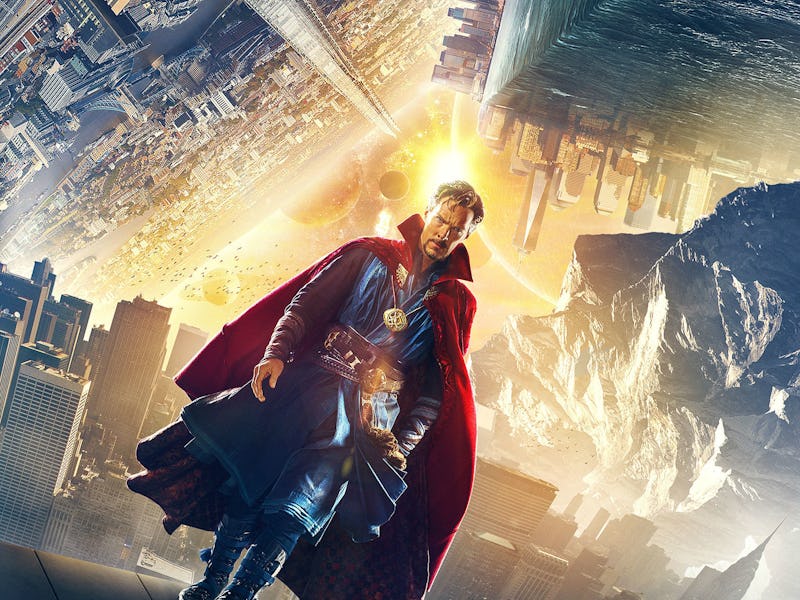Explaining How Marvel's Multiverse Works in 'Doctor Strange'
'Doctor Strange' is only the beginning in the march towards 'Infinity War.'

Scientists and comic book fans alike have pondered the multiverse for decades, but it’s only in the advent of blockbuster superhero movies that it’s been explored by a mass populace. Marvel’s Doctor Strange, the latest in the ever-expanding Marvel Cinematic Universe from director Scott Derrickson, is the first of 13 interconnected Marvel movies to explore the multiverse. But what the heck is it? And what does it matter for the likes of Spider-Man and Thor?
In short, the multiverse is an accepted concept in theoretical science which posits that our known universe exists alongside a potentially infinite number of alternates. In 1952, Noble Prize-winning physicist Erwin Schrödinger gave a lecture in Dublin in which he discussed different histories that were “not alternatives, but all [which] really happen simultaneously,” making it the first known lecture of multiverse theory.
Schrödinger told his audience in Dublin he might seem like a loon, but had he waited a few years, he would have just been a big nerd; in 1961, DC Comics introduced the multiverse in the landmark The Flash #123 in which the Flash teams up with another Flash just like him, but who hailed from a parallel Earth.
Since The Flash #123, both DC and Marvel — as well as countless other science fiction pieces before and after the comic — have explored the multiverse to tiring degrees, to the extent that comics being “overcomplicated” is a common complaint. But movies like Doctor Strange are made for anyone to understand them, and Derrickson does a hell of a job laying out the multiverse no matter your degree of comic book knowledge.
In Doctor Strange, Cumberbatch’s goateed jerkwad of a surgeon Stephen Strange is introduced to the multiverse after seeking the help of the Ancient One (Tilda Swinton). Besides wielding fancy Harry Potter-esque magic, Strange learns his class of mystics are guardians of the realms, because it would be very bad if one person were to gain control over it all.
Skeptical at fist, the Ancient One shocks Strange into a stroll through the multiverse in a dazzling display of colors and sounds that feel ripped right out of Steve Ditko’s original comics. It’s here where Strange sees the multiverse — all the alternate Earths that exist alongside his (our) own. This is a game changer for the Marvel Cinematic Universe, because now other possibilities are opened up. There could be a universe where the X-Men exist, or maybe even the actual comics. The MCU is designated as Earth-199999, in fact.
But realistically, Doctor Strange introduces the multiverse to set up Thanos and his quest for the Infinity Stones. In case it hasn’t been clear yet, Thanos (purple dude at the end of The Avengers, the rando in space in Guardians of the Galaxy) is hunting down all the Infinity Stones, which would give him nigh-infinite power in the Marvel Universe. That’s bad! So it’s a good thing superheroes are on the rise, destined to team up in Avengers: Infinity War.
Besides alternate universes, Doctor Strange also introduces “pocket universes” like the Mirror Realm, where mystics explore the Earth and bend its physical rules to their will, or the Astral Plane, in which an individual’s spiritual form can exit the body. (2015’s Ant-Man also introduced a realm, the Quantum Realm, which was only accessible by Scott Lang’s risky subatomic shrinking.)
Doctor Strange doesn’t show alternate Benedict Cumberbatches to designate alternate Earths. That’s something for TV like the CW’s The Flash, which also explores the multiverse but mainly as an excuse to get Tom Cavanagh to wear a funny hat and/or a fake mustache. (He rocks both, for whatever it’s worth.) It’s not entirely clear why Doctor Strange shoulders the burden of expanding the MCU to an actual, literal universe, but the march towards Infinity War is in full swing. The Avengers will need a guy like Strange when Thanos comes knocking.